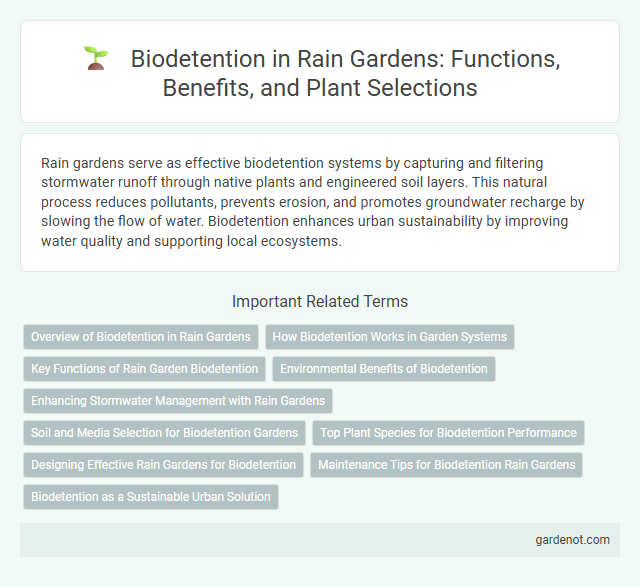Rain gardens serve as effective biodetention systems by capturing and filtering stormwater runoff through native plants and engineered soil layers. This natural process reduces pollutants, prevents erosion, and promotes groundwater recharge by slowing the flow of water. Biodetention enhances urban sustainability by improving water quality and supporting local ecosystems.
Overview of Biodetention in Rain Gardens
Biodetention in rain gardens involves the use of vegetation and engineered soil media to capture and treat stormwater runoff, enhancing water quality by removing sediments, nutrients, and pollutants. This sustainable practice mimics natural hydrological processes, promoting infiltration and reducing peak flow rates to mitigate urban flooding. The integration of native plants supports biodiversity while improving the ecological function and aesthetic value of urban landscapes.
How Biodetention Works in Garden Systems
Biodetention in garden systems operates by capturing and temporarily storing stormwater runoff in specially designed depressions filled with engineered soil and native vegetation. This process facilitates infiltration, allowing water to percolate slowly into the ground while filtering out pollutants like sediments, nitrogen, and heavy metals. The combination of soil microbes, plants, and natural processes enhances water quality and reduces the volume and velocity of runoff entering stormwater systems.
Key Functions of Rain Garden Biodetention
Rain garden biodetention plays a critical role in managing stormwater by capturing and temporarily holding runoff, which reduces peak flow rates and mitigates flooding risks. It filters pollutants such as sediments, heavy metals, and nutrients through soil and vegetation, improving water quality before it infiltrates groundwater or discharges to nearby water bodies. This natural process promotes groundwater recharge while supporting urban biodiversity by providing habitat for native plants and beneficial insects.
Environmental Benefits of Biodetention
Biodetention in rain gardens significantly reduces stormwater runoff by capturing and filtering pollutants such as nitrogen, phosphorus, and heavy metals before they reach natural water bodies. This natural filtration process improves water quality, supports groundwater recharge, and minimizes soil erosion. By enhancing urban biodiversity, biodetention areas also create habitats for native plant and animal species, contributing to ecological resilience.
Enhancing Stormwater Management with Rain Gardens
Rain gardens serve as highly effective bio-retention systems that enhance stormwater management by capturing and filtering runoff through native vegetation and engineered soil layers. These gardens reduce pollutant loads by trapping sediments, nutrients, and heavy metals before they enter water bodies, improving water quality and mitigating urban flooding. Integrating rain gardens in urban landscapes promotes groundwater recharge and slows stormwater flow, helping to restore natural hydrological cycles.
Soil and Media Selection for Biodetention Gardens
Soil and media selection in biodetention gardens is critical for optimizing stormwater infiltration and pollutant removal. A well-balanced mix typically includes sandy loam with organic matter to enhance permeability, nutrient retention, and microbial activity. Properly designed soil media supports healthy plant growth, improves water quality, and reduces runoff volume by facilitating natural filtration processes.
Top Plant Species for Biodetention Performance
Key top plant species for biodetention in rain gardens include Carex spp. (sedges), Juncus effusus (soft rush), and Lobelia cardinalis (cardinal flower), which enhance pollutant removal through extensive root systems and microbial activity. These plants effectively absorb heavy metals, nutrients, and sediments, promoting water infiltration and improving water quality. Selecting native perennial species with high tolerance to both wet and dry conditions optimizes the rain garden's performance in stormwater management.
Designing Effective Rain Gardens for Biodetention
Designing effective rain gardens for biodetention involves selecting native plant species with deep root systems to enhance soil infiltration and pollutant uptake. Proper grading ensures water is directed into the basin while preventing overflow, optimizing sediment capture and nutrient removal. Incorporating layers of amended soil and mulch supports microbial activity that further improves water quality within the rain garden system.
Maintenance Tips for Biodetention Rain Gardens
Proper maintenance of biodetention rain gardens involves regular inspection to ensure the inlet and outlet structures are free from debris and sediment buildup. Native plants should be monitored for health, with pruning and replanting performed as needed to maintain dense vegetation that enhances water filtration. Periodic removal of invasive species helps preserve biodiversity and the garden's overall pollutant removal efficiency.
Biodetention as a Sustainable Urban Solution
Biodetention functions as an effective sustainable urban solution by capturing and filtering stormwater runoff, reducing pollutants and mitigating flooding risks. This green infrastructure leverages native plants and engineered soil layers to enhance water infiltration and promote groundwater recharge. Implementing biodetention areas in cities improves water quality, supports biodiversity, and contributes to climate resilience.
Biodetention Infographic

 gardenot.com
gardenot.com